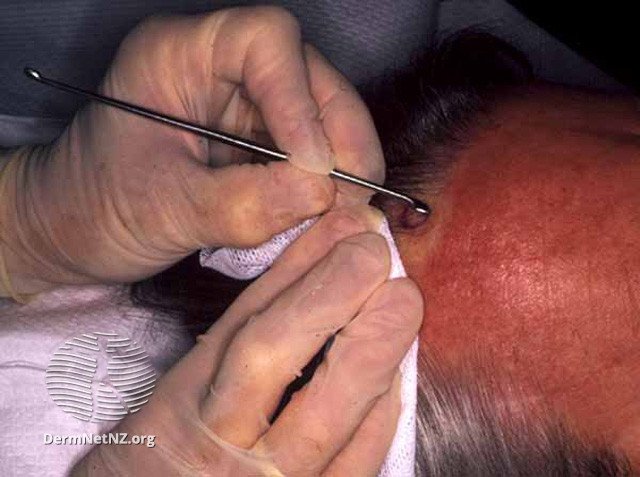
Electrodessication and Curettage (ED&C)
Using a sharp tool, called a curette, to scrape the area of skin affected by skin cancer.
Credit: DermNet NZ
Introduction to Electrodesiccation and Curettage
Electrodesiccation and curettage is a dermatological procedure, colloquially termed the "scrape and burn" method. It is primarily employed to treat certain types of skin cancers, especially in areas where traditional surgical interventions might pose challenges. The process involves numbing the targeted area, employing a curette to meticulously scrape away cancerous tissue, and subsequently using a hyfrecator to cauterize the area. The healing trajectory of this procedure leaves behind a scar, often circular in shape, reminiscent of a more profound shave biopsy.
Advantages and Procedure
The electrodesiccation and curettage technique is lauded for several merits:
Absence of Stitches: This attribute translates to fewer post-op precautions and an expedited return to daily activities.
Efficiency: The procedure is relatively swift, with any resultant discomfort typically manageable with standard pain relief medications, such as ibuprofen or acetaminophen.
Aftercare Guidelines
Post-procedure care is paramount to ensure optimal healing:
Initial 24 hours: Retain the area in a dry state, securely covered.
Subsequent Care: Post the first day, remove the protective covering, gently cleanse the treated spot with soap and water, and apply a layer of Vaseline or Aquaphor. Proceed to re-cover the area using a sizable dressing or a non-adherent pad like Telfa. Securing it with hypoallergenic Hypafix tape is suggested.
Duration: It's imperative to switch the dressing daily until the healing reaches completion, typically spanning 4-6 weeks. The healing trajectory sees the wound fill up from the base, progressively shallowing out. If, post this period, the healing seems suboptimal, it's advised to seek medical counsel.
Potential Complications
Awareness of potential complications aids in prompt intervention:
Infections: Indicators of a possible infection include heightened redness, pain unresponsive to standard pain relief, discharge of pus, or a fever surpassing 100.4°F. Prompt medical consultation is advised upon noticing these symptoms.
Bleeding: Post-operative bleeding, though rare, can occur. In such instances, exerting pressure on the area for a sustained 20 minutes is recommended. For individuals on anticoagulant therapy, having over-the-counter coagulants like BleedStop at hand can be beneficial. Persistent bleeding warrants medical intervention.
It's pertinent to note that this procedure has a marginally elevated recurrence rate, with statistics indicating that approximately 9% of treated skin cancers might recur within half a decade. Hence, regular dermatological evaluations are crucial to preemptively identify and address any recurrences.
